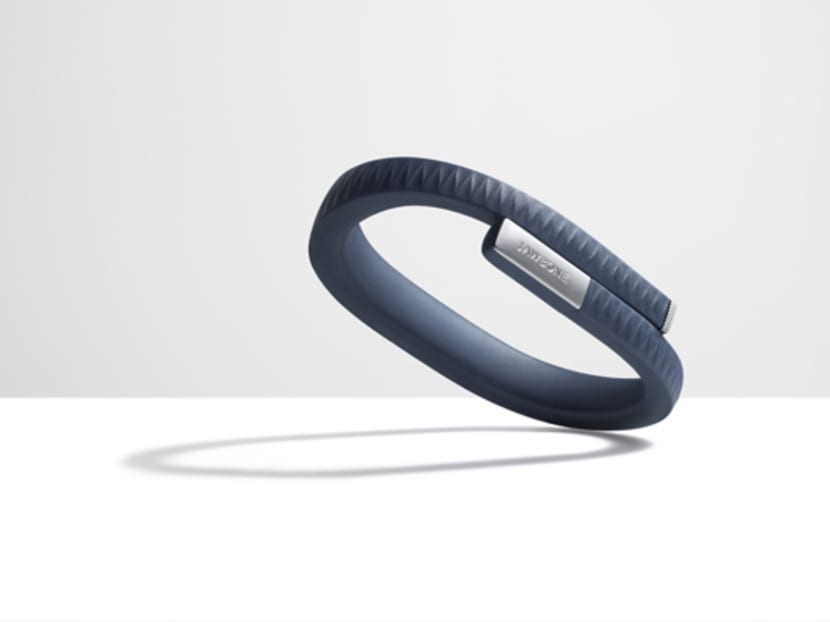It’s all in the wrist
SINGAPORE — The latest “fad” in fitness involves wearing a nagging nanny on your wrist. Dubbed lifetrackers, these wristbands measure physical activity, sleep, and the food you eat.



SINGAPORE — The latest “fad” in fitness involves wearing a nagging nanny on your wrist. Dubbed lifetrackers, these wristbands measure physical activity, sleep, and the food you eat.
Two popular such devices are the Jawbone Up and Fitbit Flex.
SIZING IT UP
Known more for their minuscule and powerful portable speakers, Jawbone’s Up is made of medical- and hypoallergenic-grade rubber. It comes in three sizes, each fitting a range of wrist sizes. My wrist sat at the lowest range of the “large” and while it didn’t slip, it looked oversized. The Flex tracker, on the other hand, is a thumb-sized device that is slipped into a rubber wrist band with an adjustable strap. While it isn’t the easiest to put on, the strap fits better and is so lightweight you won’t even know it’s there. The Flex is available in black and slate but since it is transferable, Fitbit sells a set of Teal, Tangerine, Navy bands for S$39. The Up comes in Onyx, Mint Green, Light Grey, Blue, Navy Blue, Red, Orange and Hunter Green but once you’ve picked a colour, you’re stuck with it. Both the bands are water resistant so it’s safe to take it into the shower but don’t be alarmed when water seeps into the Flex’s cradle. It can be submerged up to 10 metres of water, said its press release.
MEASURE OF THE DAY
Both devices measures the number of steps you take in a day, and lets you enter exercises that it doesn’t measure such as cycling, swimming or weight training manually. The Up is more accurate in providing the amount of calories burnt when you enter, say elliptical training, than the Flex. Both devices offer a game element by pushing you to compete with your friends to see who has taken more steps or burnt more calories in a day.
Data such as calories burnt, active time, and longest idle time are also taken. It also lets you log your meals but database are still pretty much skewed towards the American diet. You can also sync it with partner apps to track your calorie intake. I find the MyFitnessPal app to have the most comprehensive nutrition facts for local hawker food and it is available on both devices.
SLEEP TIGHT
Both the bands also track your sleep pattern but the Up edges past the Flex in that it is able to measure deep sleep versus light sleep. It also presents your sleep, diet, and activity patterns in a more visual and robust interface. Both devices offer silent alarms that vibrates to wake you without rousing the neighbourhood. The Up also has a power nap feature that wakes you up after an optimum amount of time depending on how much sleep you’ve logged the previous night.
LIGHT SHOW
Your lifeline on the Up is presented in colourful line graph interspersed with user-added photos of your meals while the Flex’s data is presented in a dual-tone statistics of the number of steps taken, sleep recorded and calorie intake. However, if you’re counting how much calories you’re eating versus calories expended, the Flex calculates the amount of calories you can consume based on your goals (mine was to lose 15kg by December) in one of its displayed data sections.
Both devices offer a display of some kind — the Up with its green Sun and Moon to show when you’re sleeping, awake, and stopwatch modes and the Flex with its LED lights that show progress toward your step goal and to celebrate with a little LED dance when you hit said goal.
CHARGE IT UP
The Flex connects to an app to your iOS or Android smartphone via Bluetooth 4.0 and it only syncs when the app is turned on and the device is within range so it drains minimal battery. However, it only holds the charge for five days while the Up only needs to be charged once every 10 days. Unfortunately, the Up needs to be sync-ed through your phone’s headphone jack, which is a bummer in today’s wireless world. The Up app is also available for iPhones, iPads and Android devices.
Jawbone’s Up may sport a more premium look and feel, and have a more colourful analytics lifeline but the Flex offers more versatility in colour bands, adjustable strap and Bluetooth connection. But, ultimately, both of these devices will nudge you toward a healthier lifestyle.
Jawbone Up is available at S$189.90 and Fitbit Flex retails for S$129. Both are available now.







